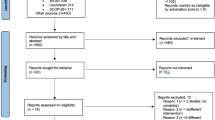Abstract
Data sources
Medline (PubMed), Embase, Cochrane Central Register of Controlled Trials and Cochrane Oral Health Group Trials Register databases and a manual search of the Journal of Dental Research, Journal of Clinical Periodontology, Journal of Periodontology and the International Journal of Periodontics and Restorative Dentistry from January 2014 to February 2015.
Study selection
Prospective, retrospective, randomised or not, case-controlled or case series trials showing the incidence or recurrence of peri-implant disease plus or minus PIMT over more than six months.
Data extraction and synthesis
Three reviewers independently selected studies and abstracted data with two reviewers assessing study quality using the Newcastle-Ottawa Scale (NOS). A multivariate binomial regression was used to examine the data.
Results
Thirteen studies were included with ten contributing to the meta-analysis. The average quality assessment score (NOS) was 5.3 out of a possible nine, only one paper achieved eight. At patient level mucositis ranged from 18.5–74.2% and peri-implantitis from 8–28%, with significant effects being seen for treatment (z= −14.36, p<0.001). Mucositis was affected by history of periodontitis and mean PIMT at implant and patient levels, respectively. For peri-implantitis there were also significant effects of treatment (z = −16.63, p<0.001). Increased peri-implantitis was observed for patients with a history of periodontal disease. (z=3.76, p<0.001). Implants under PIMT have 0.958 the incident event compared to those with no PIMT.
Conclusions
Within the limitations of the present systematic review it can be concluded that implant therapy must not be limited to placement and restoration of dental implants, but to the implementation of PIMT to potentially prevent biological complications and heighten the long-term success rate. Although it must be tailored to a patients risk profiling, our findings suggest reason to claim a minimum recall PIMT interval of five to six months. Additionally, it must be stressed that even in the establishment of PIMT, biological complications might occur. Hence, patient-, clinical-, and implant-related factors must be thoroughly explored.
Similar content being viewed by others
Commentary
Before moving on to the commentary for this systematic review I think it would be beneficial to reboot our scientific thinking systems. To do this I recommend reading or listening to Richard Feynman's 1974 Caltech Commencement Address.1
As the number of dental implants in the population increases, so has the prevalence of inflammatory lesions around these implants. The definition of peri-implant disease in its most basic sense is ‘a collective term for inflammatory reactions in the tissues surrounding an implant. Peri-implant mucositis is used to describe the presence of inflammation in the mucosa at an implant with no signs of loss of supporting bone. Peri-implantitis in addition to inflammation in the mucosa is characterised by loss of supporting bone’.2 In a recent systematic review the prevalence of peri-implantitis mucositis and peri-implantitis were 43% and 22% respectively,3 but as the authors point out, due to high heterogeneity this figure needs to be interpreted with caution. The authors here wished to investigate the impact of peri-implant maintenance therapy (PIMT) on biologic complications and implant survival, and a comprehensive literature search was undertaken which generated 13 studies which fulfilled their inclusion criteria.
The first point to note is that the authors state that the study followed the PRISMA (Preferred Reporting for Systematic Reviews and Meta-analysis) protocol,4 there was also a mention of following AMSTAR (A Measurement Tool to Assess Systematic Reviews).5 As part of both these tools the authors undertook a ‘risk of bias assessment’ of the included studies using the Newcastle-Ottawa Scale for cohort/case control studies.6The idea behind this is that only the better primary research available goes into the final analysis, so out of the 13 papers the authors whittled it down to ten. One paper scored eight out of a possible nine points (low risk of bias) and the mode being four/five (unclear to high risk of bias).
Now if you have done your homework and read Feynman you would know that it is important in science to be able to reproduce the original experiment before starting a new investigation. The best paper in this review is by Cho-Yan7 which scored eight/nine. It appears that the data set used was not independently validated and came from another study8 which was a retrospective paper where there was also no mention of independent validation either. The sample data are therefore two degrees removed from the original patient population and susceptible to selection bias, and should be downgraded from eight/nine to seven/nine. Similarly, in the two papers by Aguirre-Zorzano,9,10 the 2015 paper may possibly include the patients from the 2013 paper, and this could lead to the problem of ‘double-counting’. In the paper from Costa11 it was unclear how patients were allocated to maintenance/no maintenance groups, creating the risk of further selection bias, as the less motivated patients may be more likely to end up in the no maintenance group.
Unfortunately, it is not easy for most clinicians reading these reviews to access the full text of the primary literature or contact the authors for clarification and we have to appraise the information as presented. This is quite a common problem in systematic review12 and needs more attention when creating the research protocols. The process of conducting long-term studies is time consuming and expensive and almost impossible to reproduce in the dental environment so the ‘devil remains in the detail’. In this case, independent validation of the original data set and randomisation of the study groups. Further problems occur due to varying durations of study not mentioned in Table 4, with one paper running a study for one year post loading and others for five to ten years. Since peri-implantitis takes time to develop, one study was too short in real terms to have any external validity.
If the authors were in fact following the PRISMA protocol it would have been interesting to have followed Section 16 (additional analysis and how to make use of the risk of bias assessments) of the protocol and redo the meta-analysis without the unclear to high risk-of-bias papers. The problem with excluding two thirds of the implants is that the study becomes dramatically underpowered to detect such a small effect size. Keeping the numbers of participants high is known as ‘vote counting’ as described in a paper by Ioannidis.13
The second major problem with this review focuses on the statistical analysis and presentation of the results. Results were provided for the effects of peri-implant maintenance therapy in relation to peri-implant mucositis, peri-implantitis, periodontitis and the secondary outcome of implant survival, however they are difficult to interpret or place into context, and a table may have helped in comparing effect sizes. Charts were provided which did help in interpreting the results but they did not appear to link with the results provided in the main text. Beyond showing that the effect size between the groups was quite small, this may have been one of the reasons to include all the available data in the analysis regardless of quality. In relation to the results of the secondary outcome of implant survival rate the authors state that ‘implants under PIMT have 0.958 the incident event than those with no PIMT’ which might mean twice the survival rate or a 4% increased or decreased risk of failure. Clearer presentation of the results may have helped answer this question.
The authors did comment on the problems of bias and how previous studies could not draw a conclusion of treatment effect14,15,16 regarding maintaining health around dental implants. Unfortunately, the authors then sited two studies that are at high risk of bias to defend their argument regarding the impact of maintenance therapy.
Possibly the most interesting information that could be extracted from this study appears to have been missed by the authors. This is the difference between peri-implantitis at the implant level and patient level as shown in Figure 2 of the original review. Extrapolating from the chart itself the absolute risk reduction at the implant level of PIMT is (-)5% but at the patient level it is (-)25%. For this difference to occur there are several questions that come to mind. When the groups are allocated, do the higher risk patients end up in the no PIMT groups since they are less concerned about rigorous maintenance (selection bias) and do these higher risk patients have more implants due to increased tooth loss as a function of previous periodontal disease or recurrent periodontal (RP) disease. This factor was mentioned in Cho-Yan's paper7 where they concluded ‘that it is the presence of recurrent or RP, rather than a simple history or periodontitis, which is the risk factor for peri-implantitis’.
At the implant level it is interesting to note that even with a (-)33% relative risk reduction in infection, roughly 10% of the total implants have peri-implantitis despite the maintenance therapy which concurs with the authors' conclusion that other patient-, clinical- and implant-related factors need to be taken into consideration.
In conclusion, this review shows there is a small improvement in peri-implant tissue health with regular periodontal/PIMT but patients can still develop soft and hard tissue complications despite good maintenance. Though not mentioned directly, patients with a history of recurrent periodontitis prior to implant placement may be at the highest risk of peri-implantitis despite good oral hygiene, clinical technique or implant type. The progress with solving the problem of peri-implantitis, especially at the patient level lies with well-crafted prospective studies. These need to follow recognised reporting guidelines such as CONSORT (Consolidated Standards of Reporting Trials)17 for randomised trials and STROBE (Strengthening The Reporting of OBservational studies in Epidemiology)18 for observational studies. Dental research is always going to suffer from limitations such as study size, duration, patient retention etc, so we owe it to our patients to get the best out of every study undertaken.
References
Feynman RP, 1974. Cargo Cult Science. Engineering and Science, 33, pp.10–13. Available at: http://resolver.caltech.edu/CaltechES:37.7.CargoCult (Accessed March 2017).
Zitzmann N, Berglundh T . Definition and prevalence of peri-implant diseases. J Clin Periodontol 2008; 35: 286–291.
Derks J, Tomasi C . Peri-implant health and disease. A systematic review of current epidemiology. J Clin Periodontol 2015; 42:S158–171.
Moher D, Liberati A, Tetzlaff J . Altman DG ; PRISMA Group. Preferred reporting items for systematic reviews and meta-analyses: the PRISMA statement. PLoS Med 2009; 6:e1000097.
Shea BJ, Grimshaw JM, Wells GA, et al. Development of AMSTAR: a measurement tool to assess the methodological quality of systematic reviews. BMC Med Res Methodol 2007; 7:10.
Wells GA . 2013. Newcastle Ottowa Scale Coding Manual for Case-Control Studies. The Ottowa Hospital Research Institute. Available at: http://www.ohri.ca/programs/clinical_epidemiology/oxford.asp (Accessed March 2017).
Cho-Yan Lee J, Mattheos N, Nixon KC, Ivanovski S . Residual periodontal pockets are a risk indicator for peri-implantitis in patients treated for periodontitis. Clin Oral Implants Res 2012; 23:325–333.
Nixon KC, Chen ST, Ivanovski S . A retrospective analysis of 1,000 consecutively placed implants in private practice. Aust Dent J 2009; 54:123–129.
Aguirre-Zorzano LA, Estefanía-Fresco R, Telletxea O, Bravo M . Prevalence of peri-implant inflammatory disease in patients with a history of periodontal disease who receive supportive periodontal therapy. Clin Oral Implants Res 2015; 26:1338–1344.
Aguirre-Zorzano LA, Vallejo-Aisa FJ, Estefanía-Fresco R . Supportive periodontal therapy and periodontal biotype as prognostic factors in implants placed in patients with a history of periodontitis. Med Oral Patol Oral Cir Bucal 2013; 18:e786–792.
Costa FO, Takenaka-Martinez S, Cota LO, Ferreira SD, Silva GL . Costa JE.Peri-implant disease in subjects with and without preventive maintenance: a 5-year follow-up. J Clin Periodontol 2012; 39:173–181.
Seehra J, Pandis N, Koletsi D, Fleming PS . Use of quality assessment tools in systematic reviews was varied and inconsistent. J Clin Epidemiol 2016; 69:179–184.
Ioannidis JP . Evidence-based medicine has been hijacked: a report to David Sackett. J Clin Epidemiol 2016; 73:82–86.
Hultin M, Komiyama A, Klinge B . Supportive therapy and the longevity of dental implants: a systematic review of the literature. Clin Oral Implants Res 2007; 18:50–62.
Esposito M, Ardebili Y, Worthington HV . Interventions for replacing missing teeth: different types of dental implants. Cochrane Database Syst Rev 2014; 7:CD003815.
Grusovin MG, Coulthard P, Worthington HV, George P, Esposito M . Interventions for replacing missing teeth: maintaining and recovering soft tissue health around dental implants. Cochrane Database Syst Rev 2010; 8:CD003069.
Schulz KF, Altman DG . Moher D ; CONSORT Group. CONSORT 2010 Statement: updated guidelines for reporting parallel group randomised trials. Br Med J 2010; 340:c332.
von Elm E, Altman DG, Egger M, Pocock SJ, Gøtzsche PC, Vandenbroucke JP ; STROBE Initiative. The Strengthening the Reporting of Observational Studies in Epidemiology (STROBE) statement: guidelines for reporting observational studies. J Clin Epidemiol 2008; 61:344–349.
Author information
Authors and Affiliations
Additional information
Address for correspondence: A Monje, Department of Periodontics and Oral Medicine, University of Michigan, School of Dentistry, 1011 North University Avenue, Ann Arbor, MI 48109-1078, USA. E-mail: amonjec@umich.edu
Monje A, Aranda L, Diaz KT, Alarcón MA, Bagramian RA, Wang HL, Catena A. Impact of Maintenance Therapy for the Prevention of Peri-implant Diseases: A Systematic Review and Meta-analysis. J Dent Res 2016; 95: 372–379. 0022034515622432. [Epub ahead of print] Review. PubMed PMID: 26701350.
Rights and permissions
About this article
Cite this article
Howe, MS. Implant maintenance treatment and peri-implant health. Evid Based Dent 18, 8–10 (2017). https://doi.org/10.1038/sj.ebd.6401216
Published:
Issue Date:
DOI: https://doi.org/10.1038/sj.ebd.6401216



